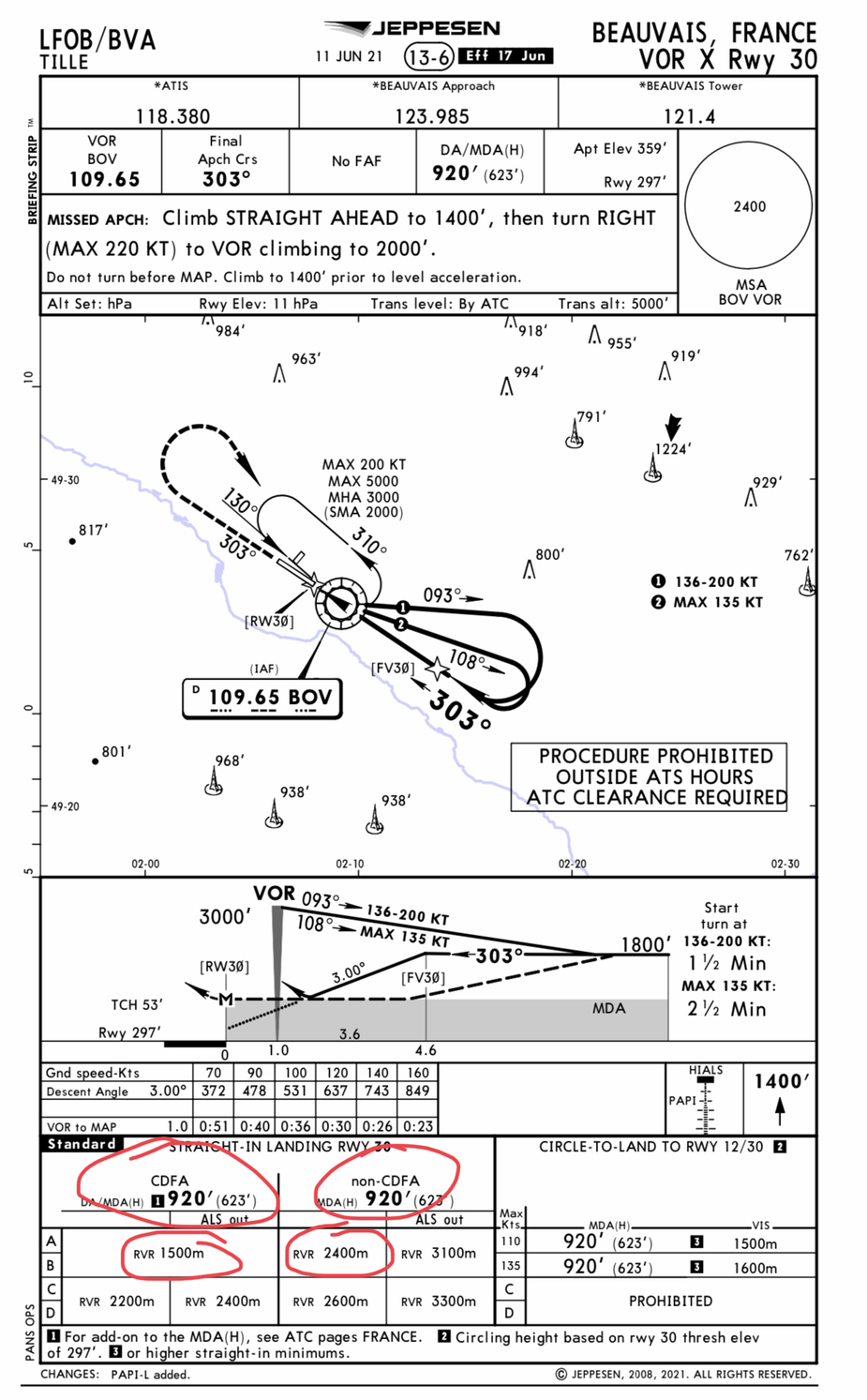Anyone knows how come Jepps has higher VIS/RVR for DnD vs CDFA on few timed NDB/VOR procedures?
Example, Beauvais LFOB VOR X RWY30
I looked at French AIP and there is no distinction, I had the impression Jepps would calculate VIS/RVR using CAT criteria but France still apply VIS/RVR state minima in the AIP plates, the latter is likely legally binding for NCO operations…
Still puzzled how come DnD has higher VIS than CDFA while both have same M/DH (+50ft or 10% ROD addons are largely academic and don’t explain -1600m delta)? doesn’t DnD bring one higher near the threshold? also why lights (ALS out) matter for DnD but not for CDFA?
What does it mean to have CTL VIS < DND VIS? you can circle fine at MDH but can’t fly straight and level straight-in at MDH with 2km visibility?


Ibra wrote:
Still puzzled how come DnD has higher VIS than CDFA while both have same M/DH (+50ft or 10% ROD addons are largely academic and don’t explain -1600m delta)? doesn’t DnD bring one higher near the threshold? also why lights (ALS out) matter for DnD but not for CDFA?
Part-NCO also has a visibility add-on for DnD, although not as large as in the LFOB plate. Table 3A of GM4 to NCO.OP.110. (I haven’t checked part-CAT.)
I’m also puzzled by this.
If I may speculate, the reason could be that as flying a DnD is less safe in the first place and has a higher pilot workload (that’s the whole rationale for CDFA) and thus the pilot should spend less time looking out for the runway environment.
Yes, it’s a question of stabilized approach and path down to the minima, I think. Especially when you have step down type approach, Roller coasting to the step down is not very safe, hence the higher minima.
I do agree DnD is less safe than CDFA but it should require less visibility? but I am damn sure straigh-in DnD is still safer and way more stable than CTL circling to the opposite runway, why the latter only require 1.5km?
Even more puzzling, I can approach in DnD on VOR then CTL legally to the non-VOR end with 1.5km if ceiling if I can see the runway from 623ft, that can’t be right !
greg_mp wrote:
hence the higher minima.
I doubt that is true above MAPt at MDH on DnD you need 623ft visibility to see the runway
From there you can always land on remaining 8000ft runway at LFOB 
So Rod Macado got all of it wrong? and zillions of DnD CFI-I fans (why not if you have 5km federal runway), that can’t be possible, they are all sleeping on the wheel
Staying higher on approach and arriving at MDA near the VDP certainly reduces your exposure to CFIT between the FAF and the VDP. Big surprise, right? It also reduces your chances of landing legally under instrument conditions (I’ll explain why, shortly).
https://rodmachado.com/blogs/learning-to-fly/dive-and-drive-ifr-propaganda
CAT.OP.MPA.110 seems to add an add-on to DnD VIS but can’t explain delta and ALS lights ON/OFF for CDFA, maybe it’s CDFA VIS minima of 1.5km that are wrong? good luck spotting the runway with 1.5km from 650ft, especially without lights, I can’t even see it with lights ON from 200ft in 2km viability unless it’s a Cat2 runway dimensions or lights


Ibra wrote:
So Rod Macado got all of it wrong?
Well… At least his blog post is mostly emotional arguments. The rest is straw man arguments or plainly wrong. He is right that you are more likely to get into the airport in marginal conditions using DnD but you do this by sacrificing safety. Not primarily by accidentally descending below the MDA before you get the runway environment in sight, but by following a too steep or shallow descent path. Macado does mention the risk of a shallow approach (the black hole effect) but then disregards it almost contemptously. As for steep approaches, remember the G-LIZZ accident at St Mary’s (EGHE) airport. That was not a DnD accident, but quite similar – the pilot saw the runway environment too late for a safe descent, attempted a landing and overran the runway. I bet Macado doesn’t like stabilised approaches either.
To me CDFA was a revelation. I was away from flying when the technique was introduced and when I started using it I was struck by how easy it was. I thought, why didn’t we always do it this way?
I agree it’s very emotional and not balanced, definitely he does not operate IFR in EGHE with 600m, so HMMV 
On days with high ceiling and low viability, it’s easy to see runway lights during the missed approach after passing over the runway numbers, one can’t resit the temptation to look under the wing but you gotta carry on and maybe save it for the next one, I imagine DnD will naturally put you on similar situation, what is the point of seeing the runway if you can’t land on it on a stable fashion?
Maybe it’s easier to land on the runway in stable fashion without seeing it 
FWIW, no airline I know of uses the D&D method… this disappeared some years ago as CDFA stats showed it to be much safer, whilst GPS accuracy and avionics vastly improved 
How does CDFA work for a timed approach?
Same as for CDFA. Timed approaches are horribly inaccurate and needs loads of protected area. And if your stopwatch runs out, you die 
Dan wrote:
FWIW, no airline I know of uses the D&D method… this disappeared some years ago as CDFA stats showed it to be much safer, whilst GPS accuracy and avionics vastly improved
CAT are not allowed to use DnD except by approval by the competent authority in each individual case. (CAT.OP.MPA.115)